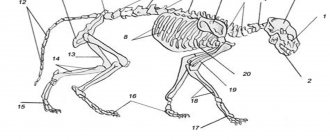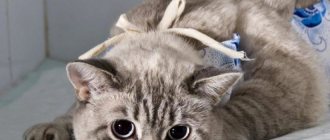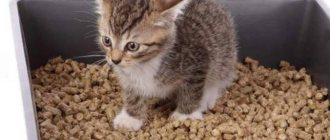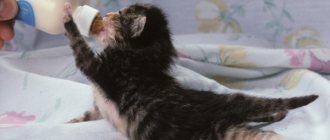In modern life, cats are the most common animals in our homes. And recently, more and more often, cats are bought not to hunt rats and mice, but to make a new friend or even a family member.
By bringing an animal into the home, a person is responsible for its life and health and undertakes to satisfy its needs. But sometimes there are situations when there is an adult cat in the house that has recently acquired offspring.
Several helpless lumps appear - two, three, five. All care for them falls on the shoulders of the owner. In this article we will look at how kittens are born, when their eyes and ear canals open, their first teeth appear, and we will analyze the changes that occur from birth until the moment the babies become independent.
Educational video about newborn kittens.
Why are babies born blind?
A cat's pregnancy lasts 55-60 days. After this short period, completely defenseless creatures appear that cannot hear, see, or empty their bowels on their own. This helplessness is characteristic of many species of mammals. There are several explanations for why furbabies are born blind.
Being born with your eyelids open could lead to the entry of dust and dirt particles into the birth canal and, as a result, further inflammation. On the other hand, during a short period of gestation, the baby does not have time to develop all the senses. And extending the natural gestation period would be dangerous for the mother cat herself.
Natural selection was also one of the factors that led to the birth of blind newborns. Their health in the future depended on what day the kittens opened their eyes - closed eyelids protected them from illness.
A baby crawling in search of its mother could injure its eyeball on a branch or stone, or collect full eyelids of dirt or sand. Therefore, nature protected the organs of vision from damage until the cub got stronger.
Factors influencing the process
Cat cubs are not born blind. Their eyelids are simply closed. This mechanism protects the organs of vision from biological fluids in the mother’s body. Subsequently, some individuals' eyes open one at a time. How many days will it take for an animal to see sight depends on many factors:
- Gestational age. The longer a cat bears her offspring, the faster they mature after birth.
- Number of cubs in the litter. 1-2 kittens have more space to develop in the womb.
- Floor. Females mature earlier than males.
- Wool length. Longhaired cats develop more slowly than shorthaired ones.
- Cat health. If the female is healthy, eats well and has not suffered any illnesses during pregnancy, the newborn's epiphany occurs at term.
- Age of the cat. The older the mother, the earlier the kittens will open their eyes.
If the pregnancy lasted at least 70 days, the cubs may be born with their eyes open or the eyelids may open immediately after birth. This should be considered a variant of the norm. However, the cat owner must take care to protect newborns from eye diseases. Pathologies develop against the background of immature tear ducts, which cannot moisturize the mucous membranes well enough.
In some cases, a kitten may be born completely blind. The pathology is associated with poor nutrition of the mother during pregnancy, heredity, etc.
Birth of babies with open eyes
Sometimes there are cases when kittens' eyes open immediately after birth. This occurs as a result of disturbances in the pregnancy process or pathologies in the health of the mother cat. But most often, a baby’s open eyelids are a sign of his belonging to a certain breed. For example, sphinxes are immediately born sighted.
When kittens open their eyes immediately after birth, there is no need to panic. In this case, the cat and litter are sent to a dark and always warm place. The babies should spend two weeks there so that the delicate tissues of the cornea are not exposed to light or mechanical damage. Veterinarians recommend trimming newborns' claws to prevent them from accidentally scratching each other.
After two weeks, the visual organ is fully formed, becomes less vulnerable, and the kitten continues to grow healthy and sighted. If this does not happen or inflammatory processes begin, then you should immediately contact the veterinary clinic. The doctor will conduct an examination and suggest an algorithm for further actions.
What does a young family need in the first days of life?
In the first days of its life, a kitten is a defenseless creature. He is completely under the care of his mother cat. In addition to feeding, the cat carries out hygiene procedures - the babies themselves are not able to go to the toilet. For several days after giving birth, the cat will not leave the “nest” with the kittens.
In the first two to three weeks of life, animals will need their own separate place. Usually this is a box with soft bedding and a hygienic diaper, which must be changed when dirty. If your pet considers that the environment surrounding the kittens is not clean enough, then she can easily move them to another place - to a closet or behind a sofa, for example.
It is better to place the box in a dark place where they will not be disturbed by light until their eyes begin to open completely. How many days can pass and what factors influence this will be discussed below.
On what day do kittens' eyes open?
The period of insight in babies does not begin immediately after birth and generally takes 2-3 days. After some time, when the kittens' eyes open completely, a dull blue iris is visible.
Breed Features
Among the main factors influencing the development of a baby’s visual organs, veterinarians name belonging to a particular breed. Thus, in short-haired or bald individuals, the eyelids open earlier than in their long-haired counterparts. Cattery owners and experts have noticed on what day kittens of different breeds have their eyes open:
- Sphinxes receive their sight first. This happens on the third day. Some newborns appear immediately with open eyelids.
- Representatives of the Siamese and Thai breeds try to see the world around them 3-4 days after birth.
- Babies of the Siberian or Persian breed begin to distinguish between light and shadow by the end of the first week.
- Ragdolls open their eyelids no earlier than three weeks of life.
Mixed breeds or yard breeds mature on average two weeks after birth. If the process takes too long, you need to call your veterinarian for advice.
Individual factors
Many factors influence how long it takes kittens to open their eyes after birth. For example, in physically healthy and strong individuals this happens earlier. At the same time, girls are characterized by faster development than boys, so the formation of their visual organs also occurs earlier.
Another factor influencing the development of babies is their living conditions. It is important to take into account the illumination of the nest: in constant twilight, the eyelids open a little faster.
The speed of insight also depends on heredity. If the mother cat previously had strong children with rapid development, then the same will happen with the rest of the litters.
Gestation period
The time when the cat was pregnant affects the opening of the eyelids in the offspring. If newborns are born prematurely, then the development of their visual organs will be delayed.
And vice versa, in post-term offspring, all processes will occur somewhat earlier than in premature or born on time counterparts. The task of the owner of a cat family is to provide the mother and newborns with all the necessary conditions for a full life.
Reasons for delay
One of the factors influencing the slowdown of natural development processes is the baby’s health status. If the baby was born weakened and was subsequently exposed to infectious or viral diseases, then he will begin to see and hear much later.
The living conditions of the litter and mother also significantly affect the pet. Excessive lighting, low temperature and unsanitary conditions have the most negative impact on the future life of the mustache.
Problems opening the eyes: what the owner can do
We warn inexperienced breeders: even if the kitten’s eyes are in no hurry to open, this does not mean that he has any problems.
Important! Each pet develops completely individually, and therefore some deviations from the deadline are quite possible. And there's nothing wrong with that.
Within the same litter there are “fast” pets, whose eyes open during the first week, and “leisurely” kittens.
In any case, it is worth paying attention to the following patterns:
- As a rule, the first baby born into the world opens his eyes faster than his siblings.
- If animals do not see sight for more than 10 days (with the exception of some breeds mentioned above), it is time to be wary. It is necessary to carefully examine the kitten's eyes, paying special attention to the presence of any types of exudate, redness, soreness and other alarming signs.
If the owner notices that blind kittens have exudate oozing from under their eyelids, or they have swollen, puffy eyelids, they should immediately call a veterinarian. In cases where there is nothing of the kind, and the small pet is active and crawls vigorously, wanting to explore the world around it, you should just wait. Surely in a couple of days nature will finally take its toll, your eyes will open naturally.
Important! Under no circumstances should you “help” open your eyes by trying to push the edges of your eyelids apart! Nothing good will come of this. Intervention is fraught with the development of inflammation and other complications (including subsequent blindness of the animal).
Kittens open their eyes: on what day do they begin to see?
The process of insight takes different times for each individual. However, every baby goes through the same stages before he begins to see. Everything happens gradually:
- Initially, a small slit forms on the inside of the eye.
- After two or three days, the iris is almost completely exposed.
- Over the next seven days after opening the eyelids, infants cannot see fully, distinguishing only light and shadow and pronounced movements.
It is interesting that the final formation of clarity and breadth of vision in animals occurs only at the end of the sixth week. By this time, the baby’s pupils react adequately to lighting, and he can actively explore the territory around him. The dull blue color characteristic of all newborns changes to that characteristic of this species by three months of life.
Features of newborn kittens
Tiny animals are born deaf, blind, with barely noticeable signs of life. This is completely normal and don’t be alarmed if the “lump” doesn’t react to you in any way.
Development will occur gradually, and humans should not interfere with this natural process.
A cat, even if this is her first birth, is endowed with all the instincts to raise her offspring. The babies will begin to hear and open their eyes soon enough, you need to be patient and wait.
© shutterstock
Possible pathologies and their treatment
If after two weeks the newborn does not open his eyelids, then you need to take a close look at the baby. Sometimes you can notice obvious signs of inflammatory processes, acidification and other pathologies. In any case, you should not hesitate to contact a veterinarian. Only a specialist can prescribe treatment.
Fusion of eyelids
This pathology manifests itself in different ways. Fusion can be complete or partial. There is a problem with the edge of the upper and lower eyelids due to changes in the structure of the tissue. As a result, the gap between the upper and lower eyelids is either completely absent or extremely narrowed.
The inflammatory process begins in the corners and purulent discharge appears. In case of partial fusion, the veterinarian, after a thorough examination, prescribes a gentle type of massage. If complete fusion occurs, then surgery will be required.
Conjunctivitis
Pathogenic microorganisms, entering the mucous membrane through small scratches or cracks, contribute to the development of an unpleasant disease. Infectious conjunctivitis significantly delays the opening time of the eyelids, complicating the entire process.
The appearance of redness, swelling, purulent discharge, as well as a crust that sticks together the eyelids is a clear sign of the disease. The veterinarian prescribes anti-inflammatory drops and ointments to the patient with conjunctivitis, which will reduce discomfort and eliminate symptoms.
Blindness
It is impossible to detect blindness at an early stage. After the eyelids open, vision is so weak that any baby can be mistaken for blind.
The problem becomes more noticeable by the age of one month. A blind individual walks unsteadily and constantly bumps into something. If you put your finger on the poor thing and move it to the side, he will not turn his head in the right direction.
But there is no need to be too upset after the doctor diagnoses him with blindness - the baby adapts perfectly, and the rest of his senses will allow him to lead a full life.
How to care for babies' eyes
After birth, kittens are very vulnerable, and the mother cat makes every effort to provide them with proper care. The owner can also help her cope with the offspring. The cleanliness of closed eyelids can be maintained by wiping them with a soft cloth soaked in chamomile decoction, a very weak solution of furatsilin or potassium permanganate.
Knowing how long it takes for kittens to open their eyes will allow you to notice problems in time and contact a specialist. If there is a delayed development or presence of symptoms of disorders, it is important to immediately contact a veterinarian.
The article is for informational purposes only. Contact your veterinarian!











